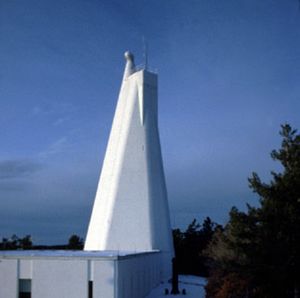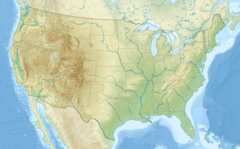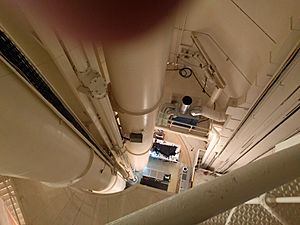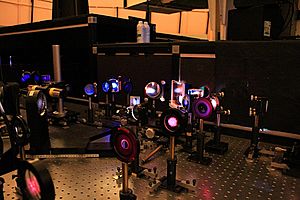Richard B. Dunn Solar Telescope facts for kids
 |
|
| Alternative names | Vacuum Tower Telescope at Sacramento Peak, Richard B. Dunn Solar Telescope |
|---|---|
| Named after | Richard B. Dunn |
| Part of | Sunspot Solar Observatory |
| Location(s) | New Mexico |
| Coordinates | 32°47′14″N 105°49′14″W / 32.78728°N 105.8205°W |
| Organization | New Mexico State University |
| Wavelength | 310 nm (970 THz)–1,000 nm (300 THz) |
| Telescope style | optical telescope solar telescope research structure |
| Diameter | 76 cm (2 ft 6 in) |
| Angular resolution | 0.1 milliarcsecond, 0.33 milliarcsecond |
| Collecting area | 0.456 m2 (4.91 sq ft) |
| Focal length | 54.86 m (180 ft 0 in) |
| Website | sunspot |
The Dunn Solar Telescope, also called the Richard B. Dunn Solar Telescope, is a special telescope that looks at the Sun. It is located in Sunspot, New Mexico, high up on Sacramento Peak. This telescope is super important for studying our Sun.
It is the main telescope at the Sunspot Solar Observatory. New Mexico State University helps run it. They get money from the National Science Foundation and other groups. The Dunn Solar Telescope takes very clear pictures and studies the Sun's light. This helps scientists around the world understand how the Sun affects Earth.
The telescope was finished in 1969. In 2004, it got a big upgrade with special technology called adaptive optics. This helps it see even better. The Dunn Solar Telescope is a key place for testing new tools and ideas for studying the Sun.
Contents
How the Dunn Solar Telescope Works
The Dunn Solar Telescope is built to get super clear images of the Sun. It also uses a method called spectroscopy. This helps scientists learn about the Sun's light and what it's made of. When it opened in 1969, it was the best telescope for seeing fine details on the Sun.
Imagine an iceberg, where most of it is hidden underwater. The Dunn Solar Telescope is a bit like that! Only a small part of it is above the ground. The telescope's journey for sunlight starts at the very top of a 136-foot-tall tower. This part is called a heliostat.
The light then travels 193 feet underground to a main mirror. This mirror sends the light back up to a special lab at ground level. The whole building, from top to bottom, works as one giant instrument.
Keeping Images Clear
The telescope's entire optical system is very long. It's longer than a football field! It also weighs over 250 tons. To keep the images clear, the inside of the telescope is a vacuum. This means there's no air inside. Without air, the heat from the Sun won't cause blurry images.
A unique feature is how the telescope rotates. The whole 250-ton telescope and its lab can turn. It hangs from a special bearing filled with mercury at the top of the tower. This rotation helps keep the Sun's image steady as the Sun moves across the sky.
Even though it's huge, scientists can control most of the telescope from one room. This room is right next to the main observing area.
Instruments for Solar Study
The Dunn Solar Telescope has a special rotating platform. Scientists can set up different tools on it. This lets them study the Sun in many ways. Here are some of the main tools they use:
- Facility InfraRed Spectropolarimeter (FIRS)
- This tool studies the Sun's magnetism. It looks at different layers of the Sun's atmosphere. It can see both visible light and infrared light.
- Spectro-POlarimeter for INfrared and Optical Regions (SPINOR)
- SPINOR was built in 2005. It is very flexible. Scientists can use it to combine many different types of light studies.
- Interferometric BI-dimensional Spectro-polarimeter (IBIS)
- IBIS takes very clear images and studies light and magnetism. It can quickly scan different parts of the Sun. This creates a series of high-quality pictures and data.
- Rapid Oscillations in the Solar Atmosphere (ROSA)
- ROSA uses six cameras to take fast pictures. It can capture up to 30 images per second. This helps scientists see how different layers of the Sun change at the same time. When it was installed in 2010, it collected a huge amount of data every day!
Some older tools are also available, but they are not used as often now.
History of the Dunn Solar Telescope
The idea for a special Vacuum Tower Telescope to study the Sun started in 1963. Building the telescope began in 1966 and finished in 1967. It cost about $3 million.
Richard B. Dunn, a very creative scientist, wrote about the telescope when it was done in 1969. He explained that they wanted to avoid blurry images. Blurry images can happen because of air movement or heat.
Dunn's team solved this by putting a window high up on a tower. Then, they removed all the air from inside the telescope. This vacuum stops air from moving around and making images blurry. It also made the observing room comfortable and warm!
More than half of the telescope building is underground. The tower goes 136 feet above ground and 220 feet below. Sunlight enters at the top. It then travels down a vacuum tube to a large mirror. This mirror sends the light back up to the labs at ground level.
The telescope's vacuum tube weighs over 250 tons. It hangs from a special bearing that holds 10 tons of mercury. This allows the entire tube to rotate. This rotation helps keep the Sun's image steady as the Earth turns.
The telescope was first opened on October 15, 1969. In 1998, it was renamed after Richard B. Dunn. A plaque there honors him as one of the best builders of solar instruments. His design was so good that almost every large solar telescope built since then has used his vacuum tower idea.
See also
- List of solar telescopes
- List of largest optical telescopes in the 20th century






